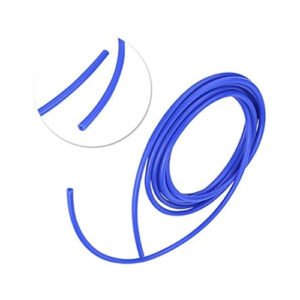Selecting the right size and configuration of silicone hoses for specific applications involves considering several factors:
- Inner Diameter (ID) and Length: Determine the required inner diameter and length of the hose based on the flow rate, volume, and distance the fluid needs to travel. Match the hose’s ID to the required flow rate without causing excessive pressure drops.
- Pressure and Temperature Ratings: Choose hoses with pressure and temperature ratings suitable for the application. Ensure the hose can withstand the maximum pressure and temperature conditions it will encounter without failure.
- Material Compatibility: Consider the compatibility of the hose material with the fluid it will transport. Ensure the silicone compound used in the hose is resistant to the specific fluid, chemicals, or environment it will be exposed to.
- Bend Radius and Flexibility: Determine the required bend radius and flexibility needed for installation within the available space. Avoid excessive bending that could restrict fluid flow or cause premature wear.
- Reinforcement Type: Evaluate if the application requires reinforced silicone hoses for added strength and pressure handling. Reinforcements like fabric, wire, or polyester can enhance hose performance in demanding applications.
- Environmental Conditions: Consider the environmental factors such as temperature variations, exposure to UV radiation, moisture, and abrasion. Select hoses that can withstand these conditions without degradation.
- Fittings and Connections: Ensure compatibility between the hose ends and the fittings or connectors used in the application. Confirm that the hose ends match the fittings and connections for a secure fit without leaks.
- Application-Specific Requirements: Take into account any unique requirements of the application. For instance, in high-vibration environments, select hoses with proper vibration resistance.
- Standards and Regulations: Check if there are industry-specific standards, certifications, or regulations that specify hose requirements for certain applications (e.g., food-grade, medical-grade).
- Manufacturer Recommendations: Consider the recommendations provided by the hose manufacturer regarding suitable sizes and configurations for specific applications.
By carefully assessing these factors and specifications, you can select the appropriate size, type, and configuration of silicone hoses that best meet the requirements of your specific application, ensuring efficient fluid transfer, durability, and reliability. Consulting with experts or manufacturers can also provide valuable guidance in the selection process.
What are the typical industries that extensively use silicone hoses?
Silicone hoses find applications across various industries due to their versatility, temperature resistance, and flexibility.
Some of the industries that extensively use silicone hoses include:
- Automotive: Silicone hoses are commonly used in automotive applications for coolant and heating systems, turbocharger connections, intake and exhaust systems, and other high-temperature and high-performance requirements.
- Aerospace: In aerospace industries, silicone hoses are utilized for fuel and hydraulic systems, engine components, and where lightweight, temperature-resistant hoses are needed.
- Medical and Pharmaceutical: Silicone hoses are preferred in medical and pharmaceutical applications for their biocompatibility, silicone hose manufacturers flexibility, and resistance to high temperatures and sterilization processes. They’re used in medical devices, fluid transfer systems, and pharmaceutical manufacturing.
- Food and Beverage: Silicone hoses are widely used in the food and beverage industry due to their compliance with food-grade standards. They’re used for transferring liquids, dairy products, beverages, and in processing and packaging equipment.
- Industrial Manufacturing: Many manufacturing processes require hoses that can withstand high temperatures, chemicals, and abrasive materials. Silicone hoses find applications in industries such as plastics manufacturing, chemical processing, and industrial machinery.
- Marine and Marine Engineering: Silicone hoses are utilized in marine applications for cooling systems, engine connections, and various fluid transfer needs due to their resistance to saltwater corrosion and temperature fluctuations.
- HVAC and Refrigeration: Silicone hoses are employed in heating, ventilation, air conditioning, and refrigeration systems due to their ability to handle temperature extremes and refrigerants.
- Electronics and Electrical: Silicone hoses are used in electronics and electrical equipment for cooling purposes, particularly in applications where high temperatures are generated.
- Renewable Energy: Industries related to renewable energy, such as solar and wind power generation, utilize silicone hoses in thermal management systems and cooling applications.
- Laboratory and Research: Silicone hoses are employed in laboratories and research facilities for various fluid transfer needs, thanks to their inertness, flexibility, and resistance to a wide range of chemicals.
These industries benefit from the unique properties of silicone hoses, which make them suitable for diverse applications requiring high performance, durability, and resistance to extreme conditions.
